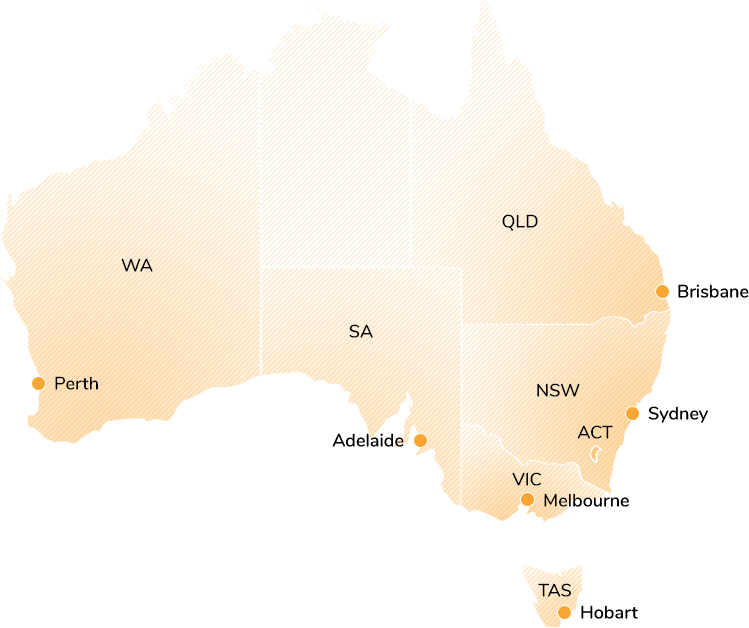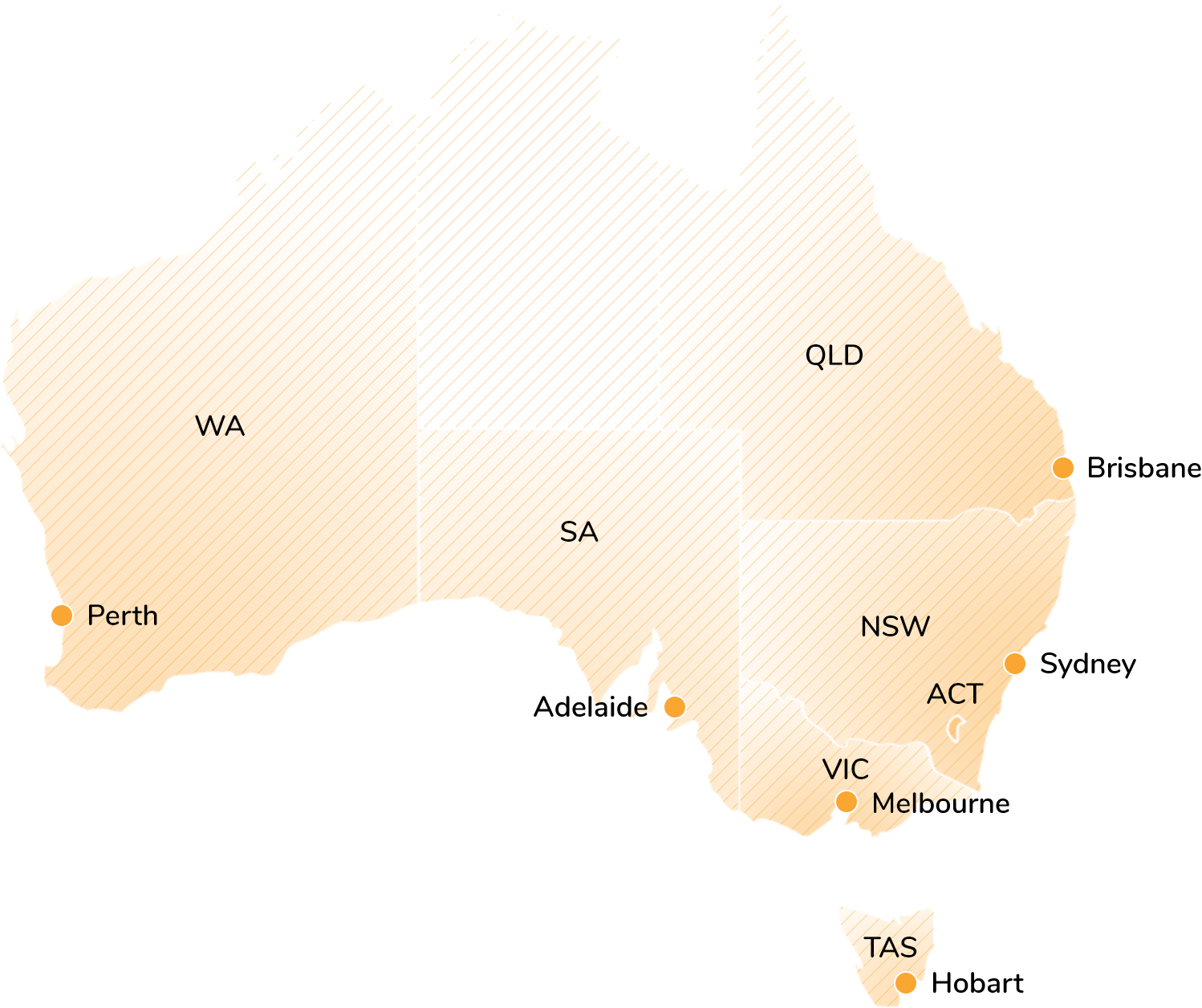How do you respectfully guess the function of a behaviour of concern? Find out in this FREE course
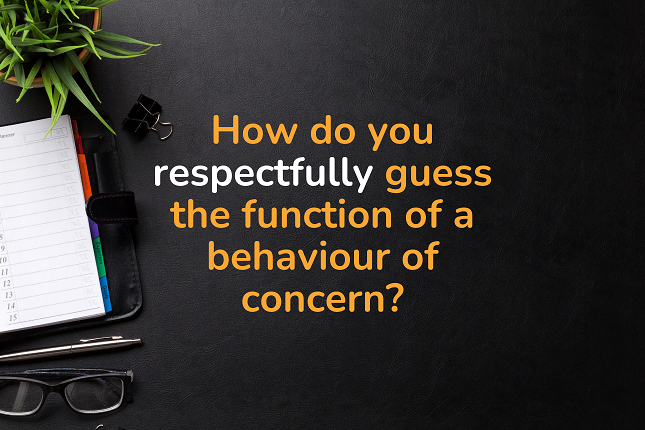
Respectfully guessing the function of a behaviour of concern is a vital part of person-centred Positive Behaviour Support. Using evidence-based practice, your Behaviour Support Practitioner will endeavour to respectfully guess why a behaviour of concern is occurring, this is also known as the function of a behaviour.
In this article, Senior Behaviour Support Practitioner, Chris Wood, outlines what a function of behaviour is, why it’s important to identify and how it fits into the broader context of a person’s behaviour and quality of life.
What is a function of a behaviour?
Behaviours of concern
First, it’s important to understand what is a behaviour of concern. A behaviour of concern is a behaviour that is having a distressing impact on a person’s quality of life and/or the people around them. In many cases, when a person is engaging in a behaviour of concern it is an attempt to meet an unmet need (e.g. hitting their support person so they will go away).
In the context of disability, a behaviour of concern can present itself in a multitude of different ways; some examples may include running onto roads, moving around a vehicle when it is moving, verbal aggression towards other people, damaging property, physically striking other people or withdrawing from key supports.

Function of a behaviour
A function of a behaviour is the “why” — that is, why the behaviour occurs and/or why it continues and/or the behaviour’s purpose (Hanley, Iwata & McCord, 2003).
In many cases, we cannot be 100% sure if the function is in all situations in which the behaviour occurs; rather, we “respectfully guess” what it is based on the information gathered at that time (assessments, data, observations, etc).
It’s important for us to understand the function of behaviour, as it better informs our intervention, giving us a greater chance of successfully intervening and improving the person’s quality of life. Some interventions that crucially link to the behaviour’s function include “Functional Equivalent Replacement Behaviours” (FERBs; replacing the behaviour with something more appropriate) and “Functional Related Replacement Behaviours” (FRRBs; other peripheral skills that might help reduce the frequency of the behaviour without directly replacing the behaviour).
Respectfully guessing the function of a behaviour of concern is a critical step within the functional behaviour assessment (FBA) process. Ironically, the word function is actually embedded within the term ‘functional behaviour process’, and often it is overlooked as a part of the positive behaviour support process.
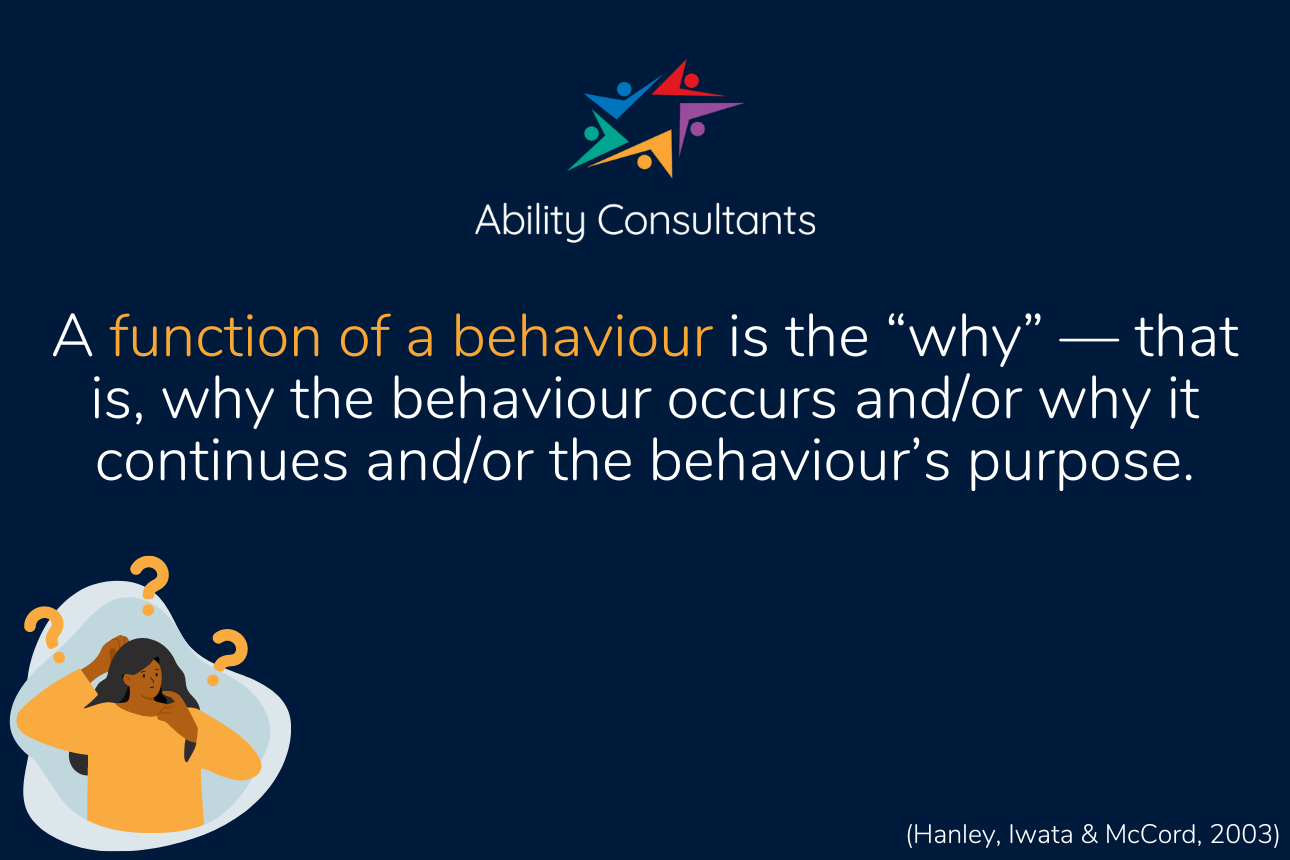
What are the different functions of behaviour?
At this current time, it’s understood that there are four functions to behaviours of concern (Paclawskyj, Matson, Rush, Smalls & Vollmer, 2001):
- Escape/avoidance: avoiding an undesirable situation (e.g. the person may drop to the ground and scream when a staff member verbally prompts them to start walking to the General Practitioner’s office for a medical appointment).
- Attention: attempting to obtain a person’s interactions/focus (e.g. a person throws their shoe at a staff member to obtain their focus).
- Tangible: attempting to access an item, person, activity, object, etc. (e.g. a person hits themself on the forehead until staff offer them their lunch).
- Sensory: the action being completed feels good to the person (e.g. a person bites the back of their hand to obtain oral input and firm pressure on the back of their hand).
The behaviour support community often refers to these four functions using any of the following acronyms: EATS, SEAT or TEAS. Please note that the definitions and examples above are extremely brief and simplified.

Why do we need to respectfully guess the function of a behaviour of concern?
In many situations, a person will engage in a behaviour of concern, as it is an effective way of having specific needs met. In some circumstances, the person has never had the opportunity to be taught an alternate way to have that need met and/or the person has attempted to use alternate ways to have this need met without success. In theory, once we understand ‘why’ the person is engaging in the behaviour of concern, we are able to develop specific interventions, such as a “Functional Equivalent Replacement Behaviour”, aka FERBs (Hanley, Iwata & McCord, 2003).
For example, a person might hit their head with a closed fist repeatedly, and support staff begin to offer the person things they like (e.g. snacks, drinks, etc). The head-hitting stops when the right item is presented to the person (e.g. a snack). For this person, the method of hitting his head was very effective in communicating that they needed something, but it was not appropriate (community standards perspective) and/or sustainable long-term (injuries, etc).
An in-depth Functional Behaviour Assessment (FBA) was conducted and it was respectfully guessed that the behaviour of concern ‘head hitting’ had a connection to the function “tangible” (more specifically, food, drink, etc). Through collaboration with key stakeholders, it was agreed that his team would attempt to teach the person how to request food using visual supports on a choice board (replace the head hitting). From here, the behaviour support practitioner developed a specific procedure, created key resources for the skill to be taught and engaged in staff training (to show the team how to teach the person the skill). Over time, the person learned to go to the choice board, select a visual (cup of water, fruit, chips, etc), and take it to the staff member. The staff member responded by supporting the person to obtain the item they requested. The visual exchange skill served the same function as the behaviour and, in effect, replaced the self-injurious behaviour.
You can see through the example, without having a clear idea of what the function might be, the intervention itself would be a complete stab in the dark. By identifying potentially ‘why’ the behaviour occurs, we are able to build a more specific intervention (e.g. FERBs, etc), and we are able to more efficiently support the person (e.g. time frames, funding, quality of life improvement, etc).
Identifying a function of a person’s behaviour of concern
Respectfully guessing
I like using the term “respectfully guess”, as in many cases, we are attempting to figure out the reason why someone might be doing something (possibly an unmet need). We respectfully guess by using alternative methods (e.g. data collection, assessment, interviews, instead of the person telling us directly). Respectfully guessing is necessary when a person may not be able to communicate effectively.
The term “respectful guessing” was introduced to me (and stuck with me) during an active support training session by Sam Arnold run by the Centre for Disability Studies program at The University of Sydney. The term aims to preserve a person’s dignity, by highlighting our own limitations, and using external information to respectfully hypothesise why the person is engaging in the behaviour of concern.
How do we respectfully guess a function of a person’s behaviour of concern?
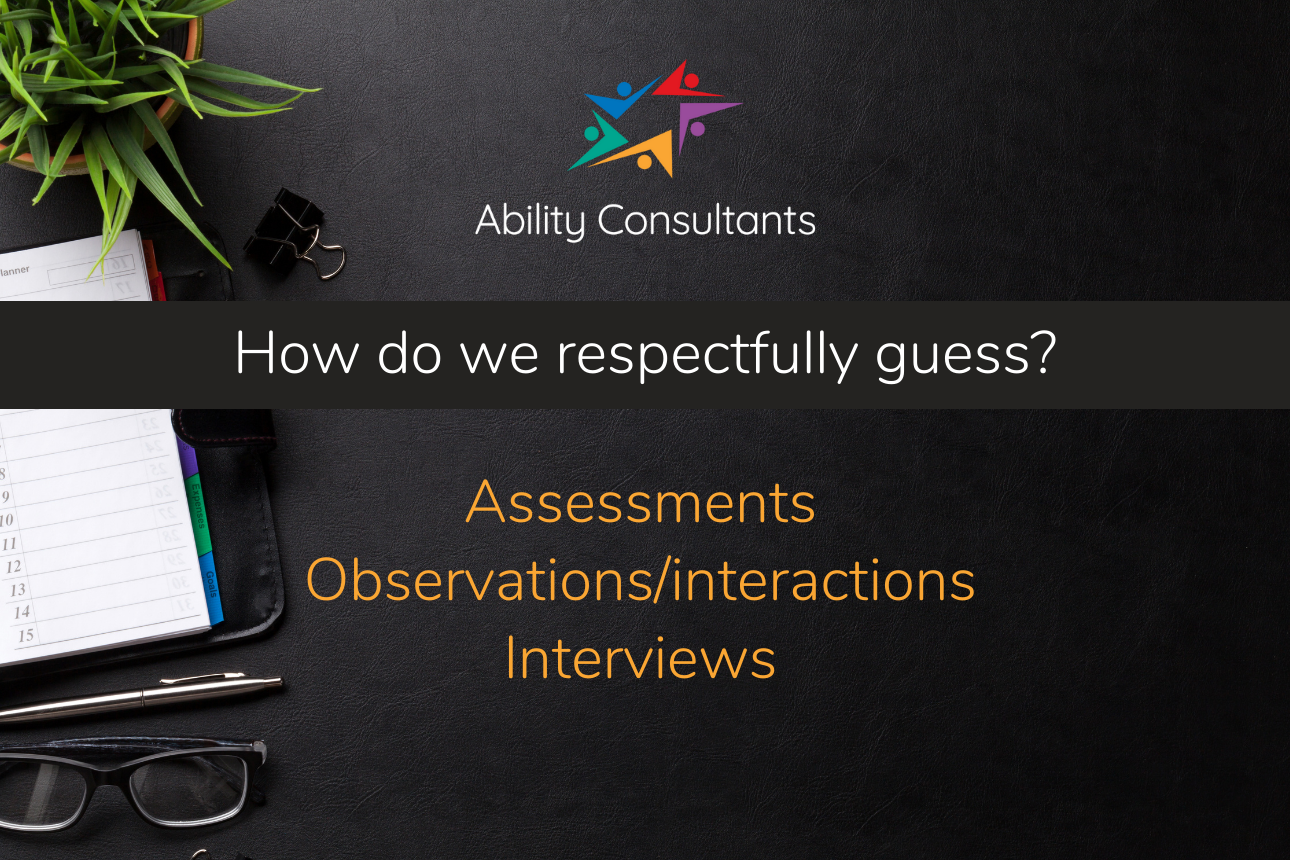
Through my experience, the best approach I can pass on is to use a “three-pronged approach”, which includes assessments, observations and interviews.
Assessments may include formal assessments (evidenced-based) such as the Motivation Assessment Scale (MAS) and informal, data-driven methods such as Antecedent Behaviour Consequence data collection (ABC data collection), review of incident reports, review of the behaviour assessment report information, etc.
Observations/interactions involve watching the person engage in key events (e.g. routines) and/or the behaviour of concern itself (e.g. witnessing a typical time when the behaviour is more likely to occur). These can be formal (using a tool, specific rules, etc.) or informal (using experience and intuition).
Interviews may be carried out with the person themselves and/or with a key person in their life (e.g. persons responsible). Interviews to respectfully guess functions of behaviour can be both formal (e.g. Functional Assessment Interview) and informal (adhoc questions using intuition and experience).
The processes above typically allow the practitioner to clearly summarise key information (e.g. frequency, severity, duration, course, etc) into the Functional Behaviour Assessment (FBA) section of the person’s behaviour support plan (often in a summary table format). The practitioner is then able to review in detail specific formal assessments relating to functions (e.g. MAS, FBI, etc), as well as, critically assess each specific trigger and setting event summarised into the FBA table. The practitioner determines if each trigger links to once of the four functions and from there they are able to develop a hypothesis (respectfully guessing “why” the behaviour is possibly occurring).
Being person-centred with our support
It is critical that during the process, we stay true to our person-centred roots, by embracing a respectful, empathetic and holistic approach to the entire process. This means considering respecting consent, working with the person’s strengths (e.g. communication preferences), respecting cultural needs, embracing a non-judgmental approach, including opportunities for self-determination and keeping in mind the person’s big picture (quality of life).
Make a referral for positive behaviour support
If you’re in need of positive behaviour support, you can make a referral on our website. We deliver person-centred, evidence-based behaviour support throughout Australia.
We support NDIS participants, to help them find more freedom and social connection through easy access to positive behaviour support.
Looking for our FREE Functions and Formulations course?
If you’re a behaviour support practitioner or work in related fields, our Functions and Formulations 3-part course will support you in your work. Our course has been designed for practitioners of all levels (core to specialist) and the material is also useful for other professionals in the disability sector.
The course has been designed to include background information as well as practical uses using real-world examples. Furthermore, our Functions and Formulations course aims to upskill behaviour support practitioners in key areas, including (not limited to):
- What a behaviour of concern is
- How to identify a behaviour of concern
- How to establish a baseline behaviour
- What a function of the behaviour is
- How to respectfully guess a function of a behaviour of concern
- How to write a hypothesis for a behaviour support plan
- How to write a formulation for a behaviour support plan
- And much more!
You can access our free behaviour support training now, from wherever you are in the world. Click here to start learning.
References:
Grey, I., & Hastings, R., 2005, “Evidence-based practices in intellectual disability and behaviour disorders”, Current Opinion In Psychiatry, 18(5), 469-475. doi: 10.1097/01.yco.0000179482.54767.cf
Hanley, G., Iwata, B., & McCord, B, 2003, “Functional analysis of problem behavior: a review”, Journal Of Applied Behavior Analysis, 36(2), 147-185. doi: 10.1901/jaba.2003.36-147
Paclawskyj,, T., Matson,, J., Rush,, K., Smalls, Y., & Vollmer, T., 2001, “Assessment of the convergent validity of the Questions About Behavioral Function scale with analogue functional analysis and the Motivation Assessment Scale”, Journal Of Intellectual Disability Research, 45(6), 484-494. doi: 10.1046/j.1365-2788.2001.00364.






